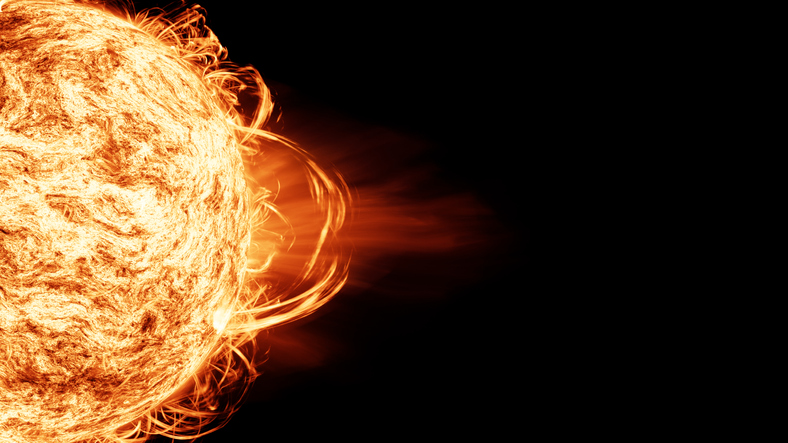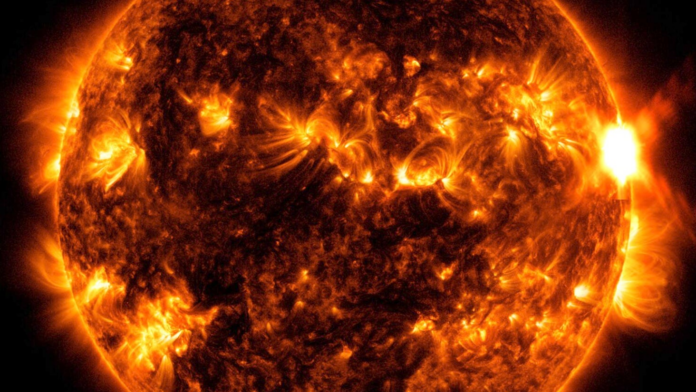On November 6, a powerful X-class solar flare erupted from the Sun, resulting in a significant radio blackout that affected parts of the Atlantic Ocean, South America, and Africa. This intense solar activity, recorded at 8:40 am ET (7:10 pm IST), briefly disrupted shortwave radio signals in the region, impacting global communications, navigation, and infrastructure.
NASA’s Solar Dynamics Observatory (SDO), dedicated to monitoring the Sun’s activity, captured an image of this solar flare event. Such occurrences are not just of interest to space scientists but have far-reaching implications for infrastructure and public safety on Earth, especially as they increase in frequency.
The Power and Classification of Solar Flares
Solar flares are categorized into classes based on their intensity: A, B, C, M, and X, with each level being ten times stronger than the last. The X-class solar flares are the most intense, capable of causing widespread disruptions on Earth. This recent event was classified as an X2.3, with “X” indicating the highest intensity category and the number providing further insight into its strength.
These intense solar bursts release vast amounts of electromagnetic radiation into space, often affecting satellite systems, power grids, and communication networks. Solar flares are known to cause high-frequency radio blackouts, as experienced in this recent event, by interfering with radio signals across affected regions.
Impact on Communication and Infrastructure
The shortwave radio blackout caused by this solar flare disrupted high-frequency (HF) communications across parts of the globe. HF signals, which are essential for aviation, maritime, and emergency services, are particularly vulnerable to solar flares due to their reliance on Earth’s ionosphere for signal transmission. During this disruption, pilots and mariners experienced degraded communication capabilities, potentially affecting operations and safety.
Beyond radio disruptions, solar flares pose risks to various critical systems, including:
- Global Navigation Systems: Interference with satellite-based navigation systems can cause inaccuracies, affecting GPS-dependent applications from personal navigation to commercial shipping and aviation.
- Power Grids: High-intensity solar flares have the potential to induce currents in power lines, which can overload electrical grids and lead to widespread blackouts.
- Astronauts and Spacecraft: Solar radiation from flares and eruptions can be dangerous for astronauts in space, potentially impacting their health and equipment. Spacecraft are also vulnerable, as the increased radiation can cause damage to critical systems and disrupt onboard electronics.
The Threat of Coronal Mass Ejections (CME)
In addition to the solar flare, scientists are now waiting to analyze data from the Solar and Heliospheric Observatory (SOHO), a collaborative mission between NASA and the European Space Agency, to determine if a coronal mass ejection (CME) accompanied this event. CMEs are massive bursts of solar wind and magnetic fields ejected from the Sun’s atmosphere. When a CME collides with Earth’s magnetic field, it can lead to geomagnetic storms that have significant consequences for our planet.
A geomagnetic storm resulting from a CME can intensify the aurora borealis, creating stunning light displays in the skies over northern regions. However, these storms also carry risks, as the increased geomagnetic activity can disrupt power systems and communication networks even further. Such geomagnetic storms have historically led to large-scale power outages and disruptions in satellite operations.
Why Solar Activity Is Increasing?
The Sun follows an approximately 11-year solar cycle, alternating between periods of high and low solar activity. We are currently moving toward a peak in this cycle, projected to occur around 2025. As a result, more frequent and intense solar flares and CMEs are expected, heightening the risk of disruptions to technology and infrastructure on Earth.
With heightened solar activity comes a greater need for monitoring and preparedness. Researchers are developing advanced tools and methods to better predict and mitigate the effects of solar flares on Earth. Governmental agencies, including NASA and NOAA, play an essential role in forecasting and issuing warnings for such space weather events, allowing industries and governments to take precautions to minimize potential damage.
Preparing for Solar Storms and Protecting Infrastructure
As the frequency of solar storms rises, experts advocate for enhanced infrastructure resilience to withstand these solar threats. Several measures are under consideration or in place to minimize the impact of solar events on global infrastructure, such as:
- Hardened Power Grids: Utility companies are working to fortify power grids with devices that can prevent or mitigate damage caused by solar-induced currents.
- Satellite Shielding: Spacecraft and satellites are being designed with enhanced shielding to better withstand bursts of radiation from solar flares and CMEs.
- Space Weather Forecasting Systems: Investments in space weather prediction technology allow for more accurate and timely warnings, enabling at-risk sectors like aviation and maritime to take preventative actions.
- Global Collaboration: Countries and space organizations are collaborating to improve data sharing and preparedness strategies, ensuring a coordinated response to extreme space weather events.
Moving Forward: The Need for Vigilance
Solar flares and associated space weather phenomena are natural occurrences, but their impact on our interconnected world is substantial. As demonstrated by the recent X-class solar flare, these events can disrupt essential services, pose risks to human health and safety, and affect critical infrastructure. The continued study and monitoring of solar activity will be vital to developing robust defense systems against these natural but disruptive forces.
For now, NASA and other space agencies will continue their diligent monitoring of the Sun, keeping the world informed of potential risks. As scientists gather more data and refine predictive models, we move closer to understanding how best to prepare for and mitigate the effects of space weather on Earth.

